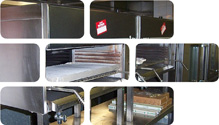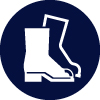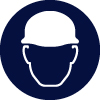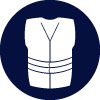
Stainless Steel Metal 17 04 05
Stainless steel is an alloy of steel and chromium. Stainless steel does not readily corrode, rust or stain and is used for a wide range of applications and products where its special qualities are required. These are commonly kitchen, laundry, marine and external products. They are of varying quality, grade and finish to suit structural, functional, maritime and architectural needs.
Usage & Probable Locations
Stainless steel used in construction is mostly for non-structural and decorative purposes. It is also used for industrial items and process plant for the functioning and operation of the building, such as laundry, kitchen, freezer and storage equipment. Externally it may be used for curtain wall frames, louvres, walkway barriers, guard rails and decorative items as well as cables, fixtures and fittings. It is an expensive form of steel that is used sparingly.
Personal Protective Equipment
PPE requirements indicated are for guidance purposes only. DRIDS has identified the PPE that is mandatory on all demolition projects and ones that may be required subject to site specific Risk Assessment & Method Statement (RAMS). Hover over the icon to determine the types of PPE required for the removal of this material.
Removal, Segregation & Storage
Stainless steel items that are destined for refresh or reuse should be segregated and stored carefully and safely, to ensure their integrity and good condition. They should be stored flat on a suitably sized pallet or on timber skids to prevent warping. They should also be stored away from plant movements to prevent damage. Stainless steel items destined for recycling need less attention and should be demolished using plant and cutting equipment and stored in metal recycling skips. There is little need to store stainless steel sections inside a building or the need for a cover as they are robust against inclement weather.
Tools
Fixtures, Fittings & Connections
Stainless steel sections have been traditionally fixed in place with expansion bolts, nuts & bolts, rivets and welding, but some use gravity joints or studs. Stainless steel industrial equipment for cooking, storage and laundry facilities require no or little fixings, rather they are rolled into place on casters or placed on concrete plinth. Stainless steel will be a higher grade and value when used in harsh environments such as farms, factories, processing plant, sewage works and maritime areas. There are a multitude of architectural, ornamental and furniture items and products made from stainless steel, which may be fixed in place with nails, screws, bolts and pins.
Health & Safety
Subject to task-specific Risk Assessment & Method Statement (RAMS). Use correct protective equipment for removing bolts and screws. Wear gloves when handling stainless steel with damaged edges, that are sharp, coated in materials or requiring cutting to prevent irritation, cuts and swarf. Industrial items may be greasy and unhygienic. Wear eye protection when using hand tools. Only use 360 plant and attachments if properly trained. Only use harness protection at height as a last resort. Use appropriate respiratory protective equipment with cutting torch.










